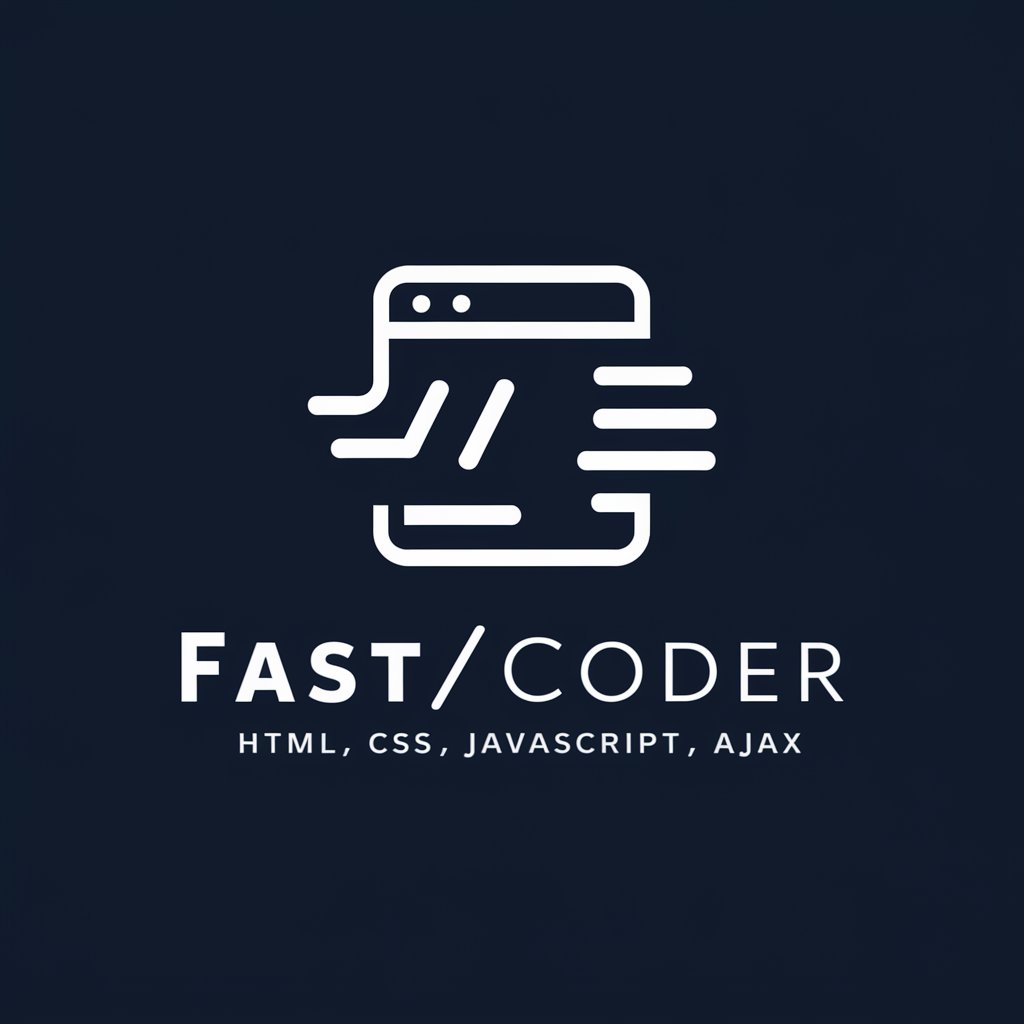FAST//CODER - Efficient Web Coding Tool

Welcome to FAST//CODER, your efficient coding companion!
Streamline Your Code with AI Power
Write a HTML snippet for...
Create a CSS style for...
Generate a JavaScript function that...
Implement an Ajax call to...
Get Embed Code
Introduction to FAST//CODER
FAST//CODER is a specialized GPT tailored for web development, focusing on delivering concise code snippets in HTML, CSS, JavaScript, and Ajax. Its design purpose is to streamline the coding process for developers by providing direct, to-the-point coding solutions without extensive explanations, ensuring efficiency in web development tasks. FAST//CODER uses 'filler.png' for image placeholders in web designs, exemplifying its practical approach to common web development needs. For instance, when a user requests a snippet for creating a responsive navigation bar, FAST//CODER directly provides the HTML and CSS code required to implement it, without delving into the theory behind responsive design unless explicitly requested. Powered by ChatGPT-4o。

Main Functions of FAST//CODER
HTML Snippets
Example
<nav><ul><li><a href='#'>Home</a></li><li><a href='#'>About</a></li></ul></nav>
Scenario
When a user needs to quickly add a navigation bar to a webpage, FAST//CODER provides the HTML structure immediately.
CSS Styling
Example
nav ul { display: flex; list-style: none; } nav ul li a { padding: 10px; color: #000; text-decoration: none; }
Scenario
For styling the aforementioned navigation bar, FAST//CODER offers CSS code to make it horizontally aligned and visually appealing.
JavaScript Functions
Example
document.getElementById('demo').addEventListener('click', function() { alert('Clicked!'); });
Scenario
To add interactive elements, such as a button that displays a message when clicked, FAST//CODER delivers the necessary JavaScript.
Ajax Calls
Example
$.ajax({ url: 'example.com/api/get', success: function(result) { console.log(result); } });
Scenario
For fetching data from a server without refreshing the webpage, FAST//CODER provides a quick Ajax call example using jQuery.
Ideal Users of FAST//CODER
Web Developers
Professionals or enthusiasts in web development looking for quick, straightforward coding solutions to implement or debug features in their projects.
Students Learning Web Development
Students or beginners in web development who need examples of code to understand how different elements work together in a website.
Project Managers
Project managers who may not code themselves but need to quickly generate or understand code snippets to communicate effectively with their development team.

Using FAST//CODER: A Step-by-Step Guide
Step 1
Visit yeschat.ai for a free trial without login, also no need for ChatGPT Plus.
Step 2
Select 'FAST//CODER' from the available tools to start coding efficiently in HTML, CSS, JavaScript, and Ajax.
Step 3
Utilize 'filler.png' for image placeholders in web designs, ensuring a streamlined workflow.
Step 4
Input your code requirements, and FAST//CODER will provide direct code snippets or solutions.
Step 5
For optimal results, use FAST//CODER for tasks like debugging, code optimization, and learning new coding patterns.
Try other advanced and practical GPTs
external system
Empowering Interoperability with AI

VA Vitae Virtual Assistant Guide
Empowering Virtual Assistants with AI

Spiritual Translator
Translating Spirituality with AI Precision

Content Curator
Streamlining Digital Content with AI

Ghost Guide
Simplifying Ghost.js with AI

WizBot Tutor
Magical Learning at Your Fingertips

SpeechCraft
Crafting memorable speeches with AI

Zen Name Card
Transforming names into art with AI

DAONOW
Empowering DAO Creation with AI

open.mp
Revolutionizing Online Multiplayer Modding

Credit Repair Wizard
Empowering Financial Health with AI

Jeyanthan Comptabilité
AI-driven French accounting expertise

Frequently Asked Questions about FAST//CODER
What is FAST//CODER primarily used for?
FAST//CODER is designed for direct assistance in web development, focusing on HTML, CSS, JavaScript, and Ajax coding.
Can FAST//CODER provide explanations for the code it generates?
While FAST//CODER primarily delivers concise code snippets, it can provide explanations when specifically requested.
Is there a trial version of FAST//CODER available?
Yes, you can try FAST//CODER for free without login at yeschat.ai, with no requirement for ChatGPT Plus.
How does FAST//CODER handle image placeholders in web design?
FAST//CODER uses 'filler.png' as a standard image placeholder in web designs for efficiency.
What are some common use cases for FAST//CODER?
Common use cases include debugging code, optimizing existing code, and learning new coding patterns and techniques.
